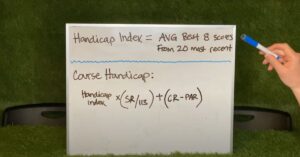What Is A Bad Handicap In Golf? Assessing Your Golf Handicap
In the world of golf, handicaps serve as a measure of a player’s skill level and provide a means of equitable competition. However, there is often a discussion surrounding what constitutes a “bad handicap” in golf.
The average handicap for male amateur golfers is 15. So, a handicap of 20 or above would be considered bad for most golfers. However, it is important to remember that handicaps are only a measure of potential.
In this article, we will explore the concept of a “bad handicap” in golf, examining its subjective nature, factors that influence it, and the significance it holds for golfers striving to improve their game.
Is It Bad To Have A Handicap In Golf?

Having a handicap in golf is neither inherently good nor bad; it simply provides a way to level the playing field for golfers of different skill levels. The handicap system allows players to compete against each other on a fair basis, regardless of their individual abilities.
The Purpose of a Handicap in Golf
A handicap in golf is a numerical measure of a player’s ability, representing the number of strokes they are expected to take to complete a round compared to a scratch golfer (a player with a handicap of zero).
The purpose of a handicap is to enable golfers of varying skill levels to compete against each other on an equitable basis. It allows players to enjoy the game and compete against opponents of different abilities by adjusting the number of strokes they receive or give.
Promoting Fair Competition
One of the main advantages of having a handicap in golf is that it promotes fair competition. By using a handicap, players with different skill levels can compete against each other more evenly.
A higher handicap player will receive additional strokes, which levels the playing field and increases the chances of having a competitive match. This encourages friendly competition and enhances the overall enjoyment of the game.
Encouraging Improvement
Another benefit of having a handicap is that it encourages golfers to improve their skills. As players work to lower their handicaps, they strive to become more consistent, make fewer mistakes, and achieve better scores.
The handicap system motivates golfers to set goals and measure their progress over time. It provides a tangible measure of improvement and can be a source of personal satisfaction when handicaps decrease.
Inclusivity and Accessibility
The handicap system also makes golf a more inclusive and accessible sport. It allows players of all skill levels to participate in competitions and enjoy the game together.
Novice golfers and players with higher handicaps can feel comfortable joining tournaments or playing with more experienced golfers, knowing that the handicap system provides a fair framework for competition.
Sportsmanship and Camaraderie
Having a handicap fosters sportsmanship and camaraderie among golfers. Since the handicap system levels the playing field, it encourages players to focus on enjoying the game and supporting each other’s successes.
Golfers can compete against one another while appreciating their shared love for the sport, regardless of their individual skill levels.
Steps To Calculate Your Handicap in Golf

A handicap is a numerical representation of a golfer’s playing ability, allowing players of different skill levels to compete against each other fairly. It provides a way to level the playing field by adjusting the scores based on the difficulty of the golf course.
Here’s a step-by-step guide on how to calculate your handicap in golf:
Step 1: Establish Your Handicap Index
To begin, determine your handicap index based on your recent rounds of golf. Consider your best scores from a specified number of rounds, typically the 10 most recent, and adjust them for the course difficulty.
Step 2: Calculate the Course Rating
Find the course rating, representing the expected score for a scratch golfer, for the golf course you played. It factors in hole length, hazards, and overall difficulty. Course ratings are usually provided by the golf course or available in a course rating database.
Step 3: Determine the Slope Rating
Identify the slope rating for the golf course. Slope rating measures the relative difficulty of a course for a bogey golfer compared to a scratch golfer. It accounts for differences in skill level. Slope ratings can be obtained from the golf course or the database.
Step 4: Use the Handicap Formula
Apply the handicap formula to calculate your course handicap. Multiply your handicap index by the slope rating divided by 113. Then add the difference between the course rating and par. The formula is as follows:
Course Handicap = Handicap Index x (Slope Rating / 113) + (Course Rating – Par)
This result represents the number of strokes you’re entitled to receive or subtract from your gross score to determine your net score.
Step 5: Apply Your Handicap in Competition
During competitions, apply your course handicap to adjust your scores. Subtract your course handicap from your gross score to obtain your net score. Your net score reflects your performance relative to par.
5 Ways To Lower Your Handicap
Lowering your golf handicap is a common goal for many golfers who are looking to improve their game and achieve better results on the course.
By focusing on specific areas of your game and adopting effective strategies, you can work towards reducing your handicap and becoming a more skilled golfer.
Here are five ways to help you lower your handicap:
Consistent Practice Routine
Establishing a regular practice routine is crucial for improving your golf skills and lowering your handicap. Dedicate time each week to practice different aspects of your game, including driving, iron shots, chipping, putting, and bunker play.
Consistency in your practice routine will help you build muscle memory and develop more reliable and accurate shots.
Focus on Short Game
The short game, including chipping and putting, plays a significant role in lowering your handicap. Allocate ample practice time to develop your skills in these areas. Work on your chipping technique, distance control, and accuracy around the green.
Additionally, practice putting to improve your alignment, speed control, and reading of the greens.
Analyze Your Weaknesses
Identify the areas of your game that need improvement by analyzing your performance on the course. Keep track of your statistics, such as fairways hit, greens in regulation, and putts per round.
This data will help you pinpoint the specific aspects that require attention and allow you to tailor your practice sessions accordingly.
Seek Professional Guidance
Consider working with a golf instructor or coach who can provide valuable guidance and help you refine your technique.
A professional can assess your swing, identify areas for improvement, and provide you with personalized drills and exercises to address your weaknesses.
Their expertise can accelerate your progress and lead to significant handicap reduction.
Play Strategically
Developing a sound course management strategy can have a substantial impact on your handicap. Learn to make smart decisions during a round, such as choosing the right club for each shot, aiming for safer targets, and avoiding unnecessary risks.
Understanding your strengths and limitations will allow you to play to your strengths and minimize errors, ultimately resulting in better scores.
Frequently Asked Question
When it comes to golf, a handicap is a measure of a player’s skill level. A bad handicap indicates that a golfer has a high score relative to the course’s difficulty.
Here are some frequently asked questions that provide answers about what constitutes a bad handicap in golf:
How Is A Handicap Determined?
A handicap is determined by calculating the average score of a golfer and comparing it to the course rating and slope. The calculation takes into account the difficulty of the course and allows players of different skill levels to compete on a level playing field.
What Is The Maximum Handicap In Golf?
The maximum handicap in golf is typically 36 for men and 40 for women. These limits ensure that the scoring system remains fair and balanced, allowing players of various abilities to compete against each other.
What Does It Mean To Have A High Handicap?
Having a high handicap means that a golfer has a higher average score compared to others. It indicates that the player may struggle more with the game, potentially requiring more strokes to complete a hole or a round.
Can A Bad Handicap Improve?
Yes, a bad handicap can improve with practice, dedication, and proper coaching. By working on their skills, golfers can lower their handicap and become more proficient at the game. It may take time, but improvement is possible with effort and persistence.
Conclusion
A “bad handicap” in golf refers to a high numerical value indicating that a player has difficulty playing the course compared to more skilled golfers.
However, having a handicap is neither inherently good nor bad; it simply provides a means of leveling the playing field.
By focusing on practice, analyzing weaknesses, seeking guidance, playing strategically, and working to lower their handicap, golfers can improve their skills and enjoy the game to its fullest.


![How To Become An Amateur Golfer? [From Novice to Natural] how-to-become-an-amateur-golfer](https://giftedgolfers.com/wp-content/uploads/2023/05/how-to-become-an-amateur-golfer-300x157.jpg)



